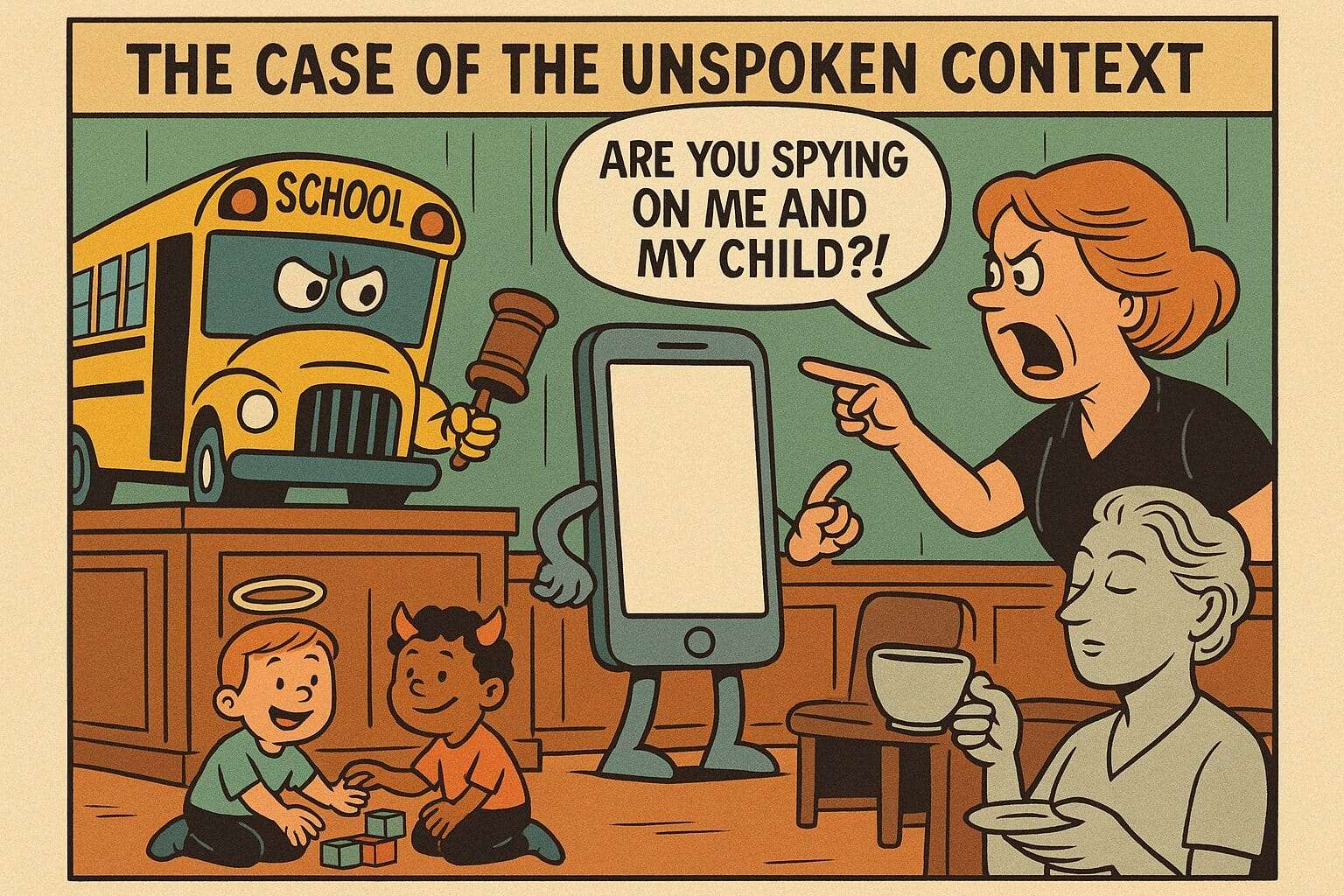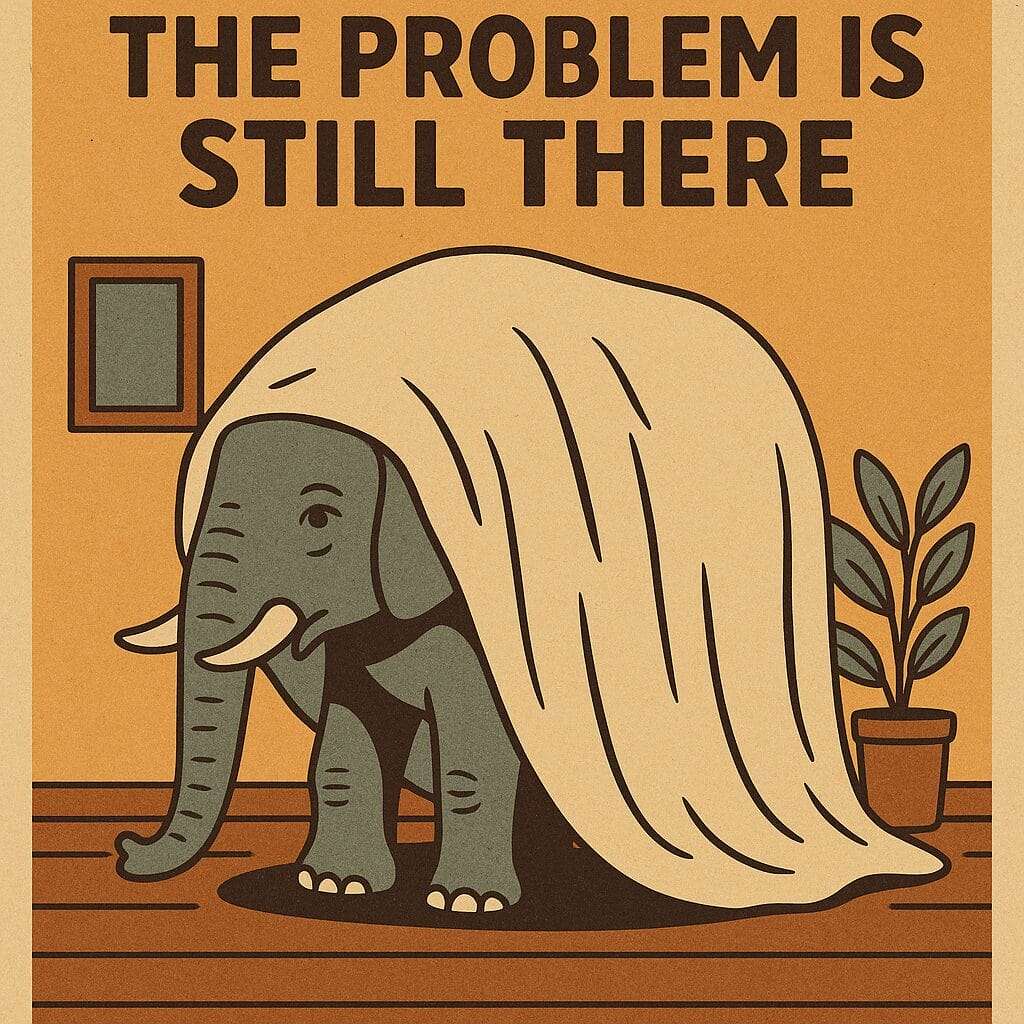
Conflict Avoidance Has a Price—Here’s How You’re Paying It
- Updated: June 20, 2025
It started with a message that landed like a punchline—except no one was laughing.
“Are you spying on me and my child?”
That was the question. No context. No curiosity. Just a veiled accusation, delivered through a text from another parent I barely knew.
Let’s call her “Karen.”
Karen had a son who’d been behaving aggressively toward mine—
yelling in his ear on the bus,
calling me “stupid” to my son,
and disrupting what should have been a safe, neutral space for our kids to just be kids.
After weeks of watching my son come home emotionally rattled, I told him the truth:
“That kind of behavior? It’s thuggish. And you deserve better.”

I didn’t mean thug as an identity—I meant it as a description of the energy:
dominating, boundaryless, intimidating.
What I was trying to teach my son is this:
observe behavior, not just words.
Pay attention to how people treat you.
And learn to trust what you see, not what others say.
Hi—I’m Denise G. Lee, and I help leaders heal what’s underneath the surface so they can lead with clarity, not fear.
This story isn’t just about parenting.
It’s about power, protection, and the patterns we inherit.
And the cost of avoiding it?
It’s higher than you think.
We’re going to talk about:
Why Conflict Avoidance Matters (Yep, Especially at Work)
Avoiding conflict doesn’t just mess with your marriage or make school pick-up awkward—it costs real money, trust, and momentum in the workplace too.
Let’s be real:
When leaders dodge hard conversations, teams get confused.
Trust erodes.
Resentment simmers.
And before you know it?
Your “productive” environment is full of silent tension and side-eye.

Here’s the kicker:
👉 A whopping 85% of employees deal with workplace conflict—and about 1 in 3 say it happens regularly.
👉 We’re talking 2.8 hours a week spent dealing with drama, misunderstandings, and unspoken frustration. That adds up to $359 billion a year in wasted time in the U.S. alone. (Yes, billion with a B.)
And leadership?
Not off the hook. Only 30% of leaders feel confident managing conflict. Half admit they don’t know how to do it well.
But here’s the good news:
Conflict isn’t the problem. Avoiding it is.
As negotiation expert William Ury says, when we lean into conflict with curiosity—not defensiveness—we unlock real connection and progress. The tension? It can actually lead to better ideas, clearer communication, and stronger teams.
Conflict, when handled well, is just honesty with a pulse.
Denise G Lee Tweet
So no, conflict avoidance doesn’t keep the peace.
It buries the truth.
And buried truth eventually explodes—quietly or loudly, but always messily.
And that’s just the professional fallout.
💔 The Personal Cost of Conflict Avoidance
Karen wasn’t the villain.
She was a mirror.
A reminder of what happens when we choose comfort over clarity.
Image over honesty.
Peacekeeping over truth.
And here’s what I’ve learned—the hard way:
Avoiding conflict doesn’t protect relationships. It slowly poisons them.
Let me break it down:

🧠 In marriage
You don’t fight—you drift.
No big blow-ups, just a slow fade.
Resentments pile up like laundry. Trust, clarity, and connection?
All quietly eroding while everyone smiles for the Christmas card.
🧒 In childhood
The “good kid” becomes the confused adult.
They learn to keep the peace, hide their truth, and walk on eggshells.
They’re praised for being easy, quiet, compliant—
but inside? A storm of unspoken needs and buried frustration.
And unless someone breaks that pattern?
It just repeats.
Generation after generation.
In our homes, our families, our friend circles.
And yep—even in how we lead.
You can’t have intimacy without truth. And you can’t build trust on silence.
Denise G Lee Tweet
Now, let’s bring it back to leadership.
(Because yes, you’re a leader—even if no one gave you a fancy title.)
Let’s talk about how conflict avoidance shows up at work—and why it’s costing more than you think.
💼 How Conflict Avoidance Shows Up at Work
(aka The Professional Version of “Let’s Just Not Talk About It”)
Let’s connect the dots between Karen and how leadership avoidance shows up at work.

1. You don’t give feedback—because you don’t want the drama.
You see someone dropping the ball.
But instead of saying something, you hope they figure it out.
You tell yourself, “It’s not worth the blowback,”
or “They’re going through a lot.”
So you soften. Or stay silent.
But here’s the deal:
People can’t fix what they don’t know.
And silence? It feels like permission.
📊 Fact drop: 69% of employees say they’d work harder if they felt more recognized and supported.
(Hint: feedback isn’t mean—it’s love with a backbone.)
2. You let messiness slide—because you don’t want to look like the bad guy.
You see the team tension.
The gossip. The weird dynamics. The passive-aggressive emails.
But you don’t say anything, because you don’t want to “rock the boat.”
Here’s what happens instead:
The boat still rocks.
But now it’s rocking on dysfunction, not direction.
3. You choose fake harmony over real health.
You want everyone to feel good.
So you keep things light. You avoid the hard stuff.
You think being nice equals being effective.
But guess what?
Nice doesn’t build trust. Honesty does.
People know when you’re dodging.
And that erodes safety faster than any blunt conversation ever could.
4. You lose credibility—one non-conversation at a time.
Over time, your team starts to notice. They see how you:
- Don’t address issues.
- Avoid eye contact when stuff gets hard.
- Ghost the tension.
And people? They stop bringing things to you.
Not because they don’t care—
but because they don’t think you do.
Avoidance doesn’t protect relationships. It erodes trust quietly, until everything healthy is gone.
Denise G Lee Tweet
Here’s the truth:
You don’t have to be harsh to be honest.
You just have to stop pretending silence is kindness.
Ready to see what that looks like in action?
Let’s flip the script.
Let’s talk about how you might be avoiding conflict… without even realizing it.
How Leaders Avoid Conflict
Okay, you might be thinking, “I know conflict avoidance is bad… but I don’t see how I’m doing it.”
Fair point. You can’t fix what you don’t see.
Let’s walk through some scenarios that reveal how avoidance shows up in sneaky (and sometimes strangely familiar) ways:

🔇 Not giving feedback out of fear of reaction
Maybe you were scripted by past leadership roles where honesty blew up in your face. You’ve dealt with some unpredictable personalities—you know, the kind who turn every conversation into a scene from As the World Turns. You don’t want to set off a loose cannon… so you stay quiet.
But silence doesn’t keep the peace—it just delays the blowup.
🧃 Letting toxic team dynamics fester
Nobody wants to make a bad situation worse. So when you saw tension between teammates, you told yourself, “They’ll work it out—they’re adults.”
You thought wrong.
Instead of resolution, it’s turned into a slow-moving mess that rivals a Real Housewives subplot. And now you’ve got front-row seats.
✌🏾 Valuing harmony over health
Some of us go full MLK-meets-Gandhi, thinking if we just stay calm and kind and spiritually centered, the problem will resolve itself.
But throwing a cloth over an elephant doesn’t erase the emotional heaviness in the room. The vibes are off—and people feel it, even if no one’s talking about it.
⏳ Losing credibility, one non-conversation at a time
Let’s be honest: underneath conflict avoidance is fear.
You think, “If I bomb this, no one will trust me again.”
That’s All-or-Nothing Thinking—a classic cognitive distortion.
Look, it might feel like your words are dropping a bomb. But what you’re really doing is preventing the slow erosion of trust, clarity, and productivity. And making sure people don’t dread pulling up to your office every day.
I’ve hinted at some deeper losses that come from avoiding conflict—but I haven’t yet talked about why we avoid it in the first place.
Let’s unpack that next.
Avoidance doesn’t protect relationships. It erodes trust quietly, until everything healthy is gone.
Denise G Lee Tweet
Why We Avoid Conflict
Let’s keep it real.
You’re smart. You care. You want to do the right thing. So why do you still find yourself dodging certain conversations, avoiding tension, or hesitating to name what’s not working?
It’s not because you’re weak.
It’s because you were trained to keep the peace—even when it cost you clarity, confidence, or self-respect.
Most of us weren’t taught how to handle conflict—we were taught to fear it.
Some of us grew up in homes where tension meant yelling or stonewalling.
Others learned that speaking up made people angry, distant, or disappointed.
So we adapted:
We smiled.
We decided to keep our mouths shut.
Then, we smoothed things over—even when it left us carrying the emotional bill.

Avoiding conflict isn’t a personality flaw. It’s usually a survival skill we’ve outgrown.
Why This Feels “Normal” (But Isn’t Healthy)
In my article How to Recognize Character Flaws (Before They Hijack Your Peace), I broke down how many of us were praised for people-pleasing, avoiding tension, or emotionally checking out—because it made things easier for the people around us. Over time, that conditioning gets mislabeled as maturity or professionalism.
But let’s be clear: chronic conflict avoidance isn’t character strength—it’s unprocessed fear dressed up as strategy.
But here’s the rub: leadership, healing, and healthy relationships all require truth-telling. And that truth often starts in discomfort.
Let’s talk about what’s really going on underneath the silence:

1. Cultural conditioning teaches us to “keep it light.”
We live in a world that praises performance, surface positivity, and “vibes.” We’re encouraged to be pleasant, productive, and inspirational—but not vulnerable, complex, or messy.
So when you ask for depth, honesty, or emotional presence, it rubs against the cultural grain. People get uncomfortable. And we’re left feeling like we’re “too much” just for wanting authentic connection.
2. Many people haven’t learned emotional safety.
They’ve never sat in a space where grief wasn’t rushed, anger wasn’t shamed, or questions weren’t met with quick-fix answers.
So when you say, “Let’s go deeper,” they interpret it as danger, not invitation. Their own unprocessed pain makes your depth feel threatening. And again—you feel like the problem.
3. Women especially are taught to self-abandon for harmony.
We’re often socialized to make things work, to keep the peace, to not rock the boat.
So when we say, “This isn’t working for me,” or “I need more,” it clashes with decades of training. That inner guilt you feel isn’t truth—it’s programming.
4. People mistake vulnerability for weakness—or drama.
Because so much of the world performs vulnerability online, when someone shows up with the real thing—raw, trembling, unscripted—it can make others recoil.
Your depth exposes their avoidance, and that can lead to subtle rejection. Which again reinforces: “Maybe I’m too much.”
🚩 Signs You’re Avoiding Conflict
(Don’t worry—we’ve all been there)
You might not think you’re avoiding conflict.
You’re just “keeping the peace,” right?
But if you’re constantly exhausted, resentful, or quietly stewing in your car after work…
yeah, this might be you.
Let’s check the signs:

1. You over-explain everything.
You feel like you have to justify every feeling, boundary, or decision.
Because heaven forbid someone misunderstands you.
“I’m not trying to be rude, I just—like, I don’t mind, it’s just that I—well, maybe it’s nothing.”
Sound familiar?
2. You say yes when you mean no.
You agree to stuff just to keep things easy.
Extra project? Sure.
Last-minute client call? Okay.
Dinner with that draining friend? Why not.
Meanwhile, your soul is quietly screaming.
3. You apologize when you’re not actually sorry.
You say “sorry” just to keep other people from getting upset.
Saying “sorry” for asking.
Thinking you need to be “sorry” for needing space.
Sorry for having an opinion.
It’s not kindness—it’s survival mode.
4. You replay convos in your head for hours.
You didn’t speak up in the moment…
but now you’ve had the perfect comeback for the past 3 hours.
And you’re still thinking about what you should have said.
5. You get anxious anytime someone’s upset with you.
Someone sends a short email.
You spiral.
Did I do something wrong? Are they mad? Should I fix it?
You bend over backwards trying to smooth everything—even when it’s not yours to fix.
If you’re nodding along right now:
You’re not weak.
And no, you’re not broken.
You’re just tired of conflict feeling like danger.
But here’s the thing:
Real connection requires realness.
You can’t have deep relationships—or lead well—without bumping into tension sometimes. The image below sums up these signs.
Now, let’s talk about what it actually looks like to face conflict without blowing everything up.
Up next: What Courage Looks Like.

💪 What Courage Looks Like
(Spoiler: It’s not yelling or having “no filter.” It’s way deeper than that.)
Most people think conflict courage means being confrontational.
Loud. Bold. Maybe a little aggressive.
But the truth?
Courage is about showing up real—without trying to control how the other person reacts.
It’s not about winning.
It’s about being honest, grounded, and willing to stay in the room.
Let’s talk about what that actually looks like:

1. Naming the behavior—without shaming the person.
You don’t have to attack character to call out what’s not okay.
“Hey, when you raised your voice in that meeting, I felt shut down.”
That’s speaking your truth honestly and with clarity.
That is courage.
2. Being direct—without being cruel.
You don’t dance around the truth.
But you also don’t drop it like a bomb.
You lead with presence, not punishment.
3. Making room for repair—not spin.
You don’t sweep it under the rug.
You don’t rush past it with “We’re fine, right?”
You give space for people to take ownership, to ask questions, to make it right.
That’s how trust rebuilds. That’s how safety grows.
You can’t lead well if you’re afraid of discomfort. And you can’t love well if you avoid telling the truth.
Denise G Lee Tweet
Courage isn’t loud.
It’s consistent.
And it’s quietly magnetic.
Want to take it deeper? Let’s wrap this up with a reflection that helps you spot where conflict avoidance might still be running the show.
Final Thoughts: Yes, You Can Handle the Hard Stuff With Ease
I’m not here to make you feel ashamed for avoiding conflict.
I’m here to help you name it—so you can stop shrinking, overexplaining, or second-guessing your truth.
Because conflict isn’t the enemy.
Disconnection is.
And when we avoid the hard stuff, we slowly disconnect from our voice, our people, and our power.
Courage doesn’t mean being loud.
It means being real—especially when it’s uncomfortable.
If you’re in a season of leading, parenting, or partnering from a place of peace-faking instead of peace-making, please hear this:
🛑 You don’t have to abandon yourself to keep the peace.
🗣️ Nor do you have to explain your boundaries to make them valid.
🧭 And you certainly don’t need a script—you need self-trust.
The truth doesn’t have to be brutal. But it does have to be told.
Denise G Lee Tweet
If this resonated, here are a few ways we can stay connected:
🎧 Listen to the podcast – for honest conversations on leadership, healing, and emotional growth
💌 Write me a note – if you’ve got something on your heart you want to share
🤝 Explore working together – if you’re ready to do the deeper work around boundaries, voice, and self-leadership
You’re not too much. You’re not too late.
And you don’t have to fake your way through any of it.





